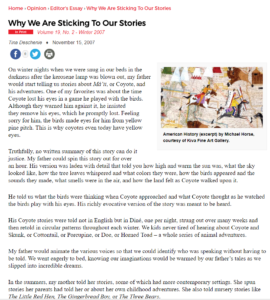Author: Tina Deschenie
Summary: In recounting the power of the oral tradition of storytelling, Tina Deschenie describes the mesmerizing experience of listening to her father tell elaborated stories in the Diné language about Coyote as well as numerous other literacy practices grounded in “the power and beauty of oral tradition and face-to-face storytelling.” This piece could be used within professional development or study groups advocating for culturally relevant practices, bi-literacy, family and community traditions, and exploring innovative ways to bring native stories, that might range from capturing oral histories to digital animation, into classrooms.
Original Date of Publication: Winter 2007
Excerpt
On winter nights when we were snug in our beds in the darkness after the kerosene lamp was blown out, my father would start telling us stories about Má’ii, or Coyote, and his adventures. One of my favorites was about the time Coyote lost his eyes in a game he played with the birds. Although they warned him against it, he insisted they remove his eyes, which he promptly lost. Feeling sorry for him, the birds made eyes for him from yellow pine pitch. This is why coyotes even today have yellow eyes…
Truthfully, no written summary of this story can do it justice. My father could spin this story out for over an hour. His version was laden with detail that told you how high and warm the sun was, what the sky looked like, how the tree leaves whispered and what colors they were, how the birds appeared and the sounds they made, what smells were in the air, and how the land felt as Coyote walked upon it.
He told us what the birds were thinking when Coyote approached and what Coyote thought as he watched the birds play with his eyes. His richly evocative version of the story was meant to be heard…
I’m glad I heard my people’s stories as a child, because in boarding school and public school, I heard no Coyote stories or Diné stories of any kind…
As No Child Left Behind seeks to shape a more literate society, we must remember that we come from cultures rooted in the power and beauty of oral tradition and face-to-face storytelling.
We must tell our story our way.
Related Resources
- Writing from the Feather Circle
- Honoring the Word: Classroom Instructors Find That Students Respond Best to Oral Tradition
- Writing, Place, and Culture: Indian Education for All
Original Source: National Writing Project, https://www.nwp.org/cs/public/print/resource/2609
